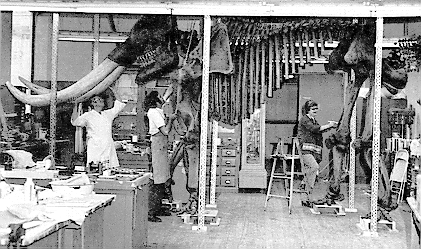Pleistocene Mammals in the Midwest
Related Biomes
American Mastodont
American mastodont, Mammut americanum
The American mastodont (Mammut americanum) roamed North America from at least 3.75 million to 11,000 years ago. Mastodons, along with mammoths and modern elephants, are members of the order Proboscidea
Mounted American mastodont on display in the Changes Exhibit at the Illinois State Museum, Springfield.
Height: 2.5-3 m (8-10 ft)
Weight: 3500-5400 kg (4-6 tons)
Physical Description:
Although they weighed approximately the same, mastodons were shorter in height, with a longer body than mammoths. They are characterized by a long, low skull containing pronounced upper tusks. The curvature of the upper tusks is usually within the same plane as the skeleton (like modern elephants). Even the lower jaw often had small, rod-like tusks. Cheek teeth were composed of a series of blunt, conical cusps, thus the name masto (nipple) -dont (tooth). Although these teeth would be well-suited to browsing trees and shrubs in the forested Midwest during the late Pleistocene, mastodon remains are also present in areas that would have been more open, suggesting some flexibility in their diet. In keeping with their relatively short, heavy bodies, mastodons were supported by robust limb bones.
A mounted skeleton of a mastodon is on display in the Changes exhibit at the Illinois State Museum in Springfield, Illinois. This skeleton is a composite of several mastodon skeletons found during excavations undertaken by the Illinois State Museum at the Boney Springs locality near Fristoe, Missouri, in the late 1960s and early 1970s. The site is currently underwater, submerged under Harry S. Truman Lake.
Generally, mastodons are associated with forested habitats. They are especially common in the Midwest after the last glacial maximum, as forests replaced tundra in recently deglaciated terrain. The abundance of mastodons in the upper Midwest during this time is associated first with open Spruce-dominated parkland (~16,000 years ago) then deciduous forests (~14,000 years ago). To the southwest in Missouri, mastodont remains found in spring deposits were associated with open spruce and pine parklands. Pollen, logs, and identifiable pieces of plants indicate these animals lived in more open parkland dominated by spruce and pine trees. A total of 31 mastodonts were recovered from the Boney Spring locality (Saunders 1977).
Tooth morphology in the American mastodont suggests that they are well-adapted to browsing woody vegetation, trees and shrubs. Some mastodons have even been excavated with partially digested plants in their stomach. During the excavation of the Burning Tree mastodont in Licking County, Ohio, scientists found a mass of pungent plant material in the area where the stomach would have been (Lepper et al. 1991). This mass consisted of seeds of clover, sedges, and naiads, with fewer seeds of pondweed, water lily, and pigweed. These researchers also isolated a variety of anaerobic bacteria from this gut mass, convincingly demonstrating that this bacterial community was once part of the intestinal flora of the Burning Tree mastodont (Rhodes et al. 1998).
Stomach contents provide highly detailed insight into the short-term diet of well-preserved mastodons. Studies of the chemistry of mastodont bones and teeth can be useful for understanding broader trends in mastodon diets since they are not as dependant on the spectacular preservation of gut contents. Generally, these studies support a diet of cool-season plants (including sedges, herbs, and woody vegetation) although there has been some evidence of anomalous mastodon diets as these populations approached extinction. The Brewster Creek mastodon near Chicago has bone chemistry values that are best explained by a diet made up almost exclusively of aquatic plants (Saunders et al. 2010).
Even though most mastodon finds in the Midwest are of isolated, individual animals, scientists believe they formed larger family groups, like modern elephants. These groups consisted of a matriarch and her family. Males would remain with the herd until adolescence, when they would leave to join small bull herds. Growth increments in mastodont tusks have the potential to provide highly detailed records of an animal’s life. Like tree rings, the tusks record prominent life events, such as birth or dispersion from the natal herd, as well as periods of diet stress (Fisher 2009).
The American Mastodont has been found throughout North America, but was concentrated in the southern Great Lakes. Bog and fen areas in the formerly glaciated parts of Illinois, Indiana, Michigan, and Ohio have produced many of our most complete skeletons. Since these areas are under-water and not often exposed to a strong current, mastodon bones are not typically sorted by current or wave action. They also remain in association with plants and other animal remains that are useful for reconstructing mastodon habitats.
As with many of the megafauna, the American Mastodont went extinct at the end of the Pleistocene. However, since this species is so common in museum collections, we have a better understanding of the timing of this extinction than with most of megafauna. Mastodons in the Midwest went extinct approximately 12,800 years ago as regional landscapes changed from cool, wet forests to cold and dry parkland. There are many sites from throughout the Midwest that date to the centuries leading up to extinction suggesting that adequate mastodon habitats were widespread until shortly before extinction. The last mastodons in the region are a pair of females from Schimelphenig Bog in Dane Co., WI.
Mastodons have been found throughout the Midwest and Great Lakes. A number of Midwestern localities yielded the remains of multiple animals: Boney Springs, Missouri (N=31), Bamford Farm, Illinois (N=5), Couch Cave, Illinois (N=13), and Bothwell, Indiana (N=13). The birthplace of American vertebrate paleontology, Big Bone Lick (Kentucky) near the Ohio River Valley, may have had the most mastodons of all, but the specimens are scattered to museums worldwide, so are difficult to count.

The Illinois State Museum Mastodon Factory, 1974.
The ISM Mastodon Factory, 1974. In this picture Marion Hoffman, Jim McGregor, and Dorothy Langer are working on the nearly completed mastodon mount for the museum. The picture was taken in the fall of 1974 shortly before the mount went on exhibit. The mount has an internal armature; this means that none of the supporting structure can be seen when viewing the mastodon. During the late 1980s and early 1990s, this scene again became a familiar one at the Illinois State Museum. This is because teams of scientists and artists under the direction of Dr. Russell W. Graham produced and assembled mastodon skeleton casts for other museums.
The ISM has produced custom mastodon mounts for the following institutions:
- Pink Palace Museum (Memphis, Tennessee)
- Mastodon State Historic Site (Kimmswick, Missouori)
- Peale Museum (Baltimore, Maryland)
- Dayton Museum of Natural History (Dayton, Ohio)
- Museum of Arts and Sciences (Rochester, New York)
- Houston Museum of Natural Sciences (Houston, Texas)
- Grand Rapids Public Museum (Grand Rapids, Michigan)
- Canadian Museum of Nature (Ottawa, Ontario, Canada)
Fisher, D. C. (2009). Paleobiology and extinction of proboscideans in the Great Lakes region of North America. In American megafaunal extinctions at the end of the Pleistocene (pp. 55-75). Springer Netherlands.
Lepper, B. T., Frolking, T. A., Fisher, D. C., Goldstein, G., Sanger, J. E., Wymer, D. A., ... & Hooge, P. E. 1991. Intestinal contents of a late Pleistocene mastodont from midcontinental North America. Quaternary Research, 36(1), 120-125.
Rhodes, A. N., Urbance, J. W., Youga, H., Corlew-Newman, H., Reddy, C. A., Klug, M. J., ... & Fisher, D. C. 1998. Identification of bacterial isolates obtained from intestinal contents associated with 12,000-year-old mastodon remains. Applied and environmental microbiology, 64(2), 651-658.
Saunders, J. J. (1977). Late Pleistocene vertebrates of the western Ozark highland, Missouri (Doctoral dissertation, University of Arizona.).
Saunders, J. J., Grimm, E. C., Widga, C. C., Campbell, G. D., Curry, B. B., Grimley, D. A., ... & Treworgy, J. D. (2010). Paradigms and proboscideans in the southern Great Lakes region, USA. Quaternary International, 217(1), 175-187.



